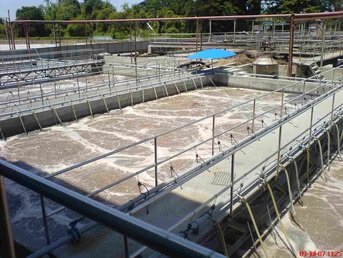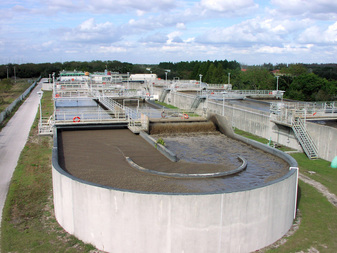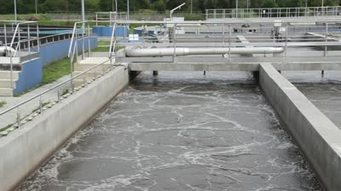Aerated Wastewater Treatment Plants Guide
On-site sewerage facilities
On-site sewerage facilities, aerobic or aerated treatment systems and septic systems are used for the treatment of domestic sewage on premises in unsewered areas.
An aerobic treatment system or ATS, sometimes called Aerated Wastewater Treatment Plant (AWTP) is a small scale sewage treatment system similar to a septic tank system, which uses an additional aerobic process {Majority of Systems} or a fully aerobic system using an activated sludge for digestion {Ozzi Kleen} rather than just the anaerobic process used in septic systems. These systems are found in semi-rural or rural areas where public sewers are not available, and may be used for a single residence or for a small group of homes or shops.
Unlike the traditional septic system, the aerobic treatment system produces a high quality secondary effluent, which can be disinfected and used for surface irrigation. This allows much greater flexibility in the placement of the approved distribution {land application} area.
On-site sewerage facilities, aerobic or aerated treatment systems and septic systems are used for the treatment of domestic sewage on premises in unsewered areas.
An aerobic treatment system or ATS, sometimes called Aerated Wastewater Treatment Plant (AWTP) is a small scale sewage treatment system similar to a septic tank system, which uses an additional aerobic process {Majority of Systems} or a fully aerobic system using an activated sludge for digestion {Ozzi Kleen} rather than just the anaerobic process used in septic systems. These systems are found in semi-rural or rural areas where public sewers are not available, and may be used for a single residence or for a small group of homes or shops.
Unlike the traditional septic system, the aerobic treatment system produces a high quality secondary effluent, which can be disinfected and used for surface irrigation. This allows much greater flexibility in the placement of the approved distribution {land application} area.
Process
The ATS process generally consists of the following phases:
The disinfecting stage is to produce a sterile effluent for distribution below or above ground. The disinfectant typically used is tablets of calcium hypochlorite, which are specially made for waste treatment systems. Unlike the chlorine tablets used in swimming pools, which are stabilized for resistance to breakdown in ultraviolet light, the tablets used in waste treatment systems are intended to break down quickly in sunlight. Stabilized forms of chlorine will persist after the effluent is dispersed, and can kill off plants in the land application area.
The ATS process generally consists of the following phases:
- Primary stage to remove large solids and other undesirable substances from the wastewater that rise to form a scum or settle to form sludge which must be periodically removed from the system. This stage acts much like a septic system. An ATS may be added to existing suitable sized septic tank systems to further process the primary effluent.
- Aeration stage, where the aerobic bacteria further digest the biological wastes in the wastewater, or a single stage Activated sludge system. This is where complete digestion of organic waste takes place in the oxygen rich environment, using naturally occurring bacteria and the organic waste in the system to produce treated high quality water.
- Disinfecting stage, where chlorine or similar disinfectant is mixed with the water, to disinfect the final liquid prior to distribution.
The disinfecting stage is to produce a sterile effluent for distribution below or above ground. The disinfectant typically used is tablets of calcium hypochlorite, which are specially made for waste treatment systems. Unlike the chlorine tablets used in swimming pools, which are stabilized for resistance to breakdown in ultraviolet light, the tablets used in waste treatment systems are intended to break down quickly in sunlight. Stabilized forms of chlorine will persist after the effluent is dispersed, and can kill off plants in the land application area.
|
Since the Aerobic Treatment System contains a living ecosystem of microbes to digest the waste products in the water, excessive amounts of substances such as bleach or antibiotics can damage the ATS environment and reduce treatment effectiveness. Non-digestible items should also be avoided, as they will build up in the system and require more frequent sludge removal. Dumping of any substance into the household drainage fixtures connected to the ATS can kill or inhibit the microbes reducing the efficiency of the system. (An easy rule to remember ‘any items with “anti” as a prefix could damage the ATS environment’)
|

Types of aerobic treatment systems
In Queensland small scale aerobic systems generally use a batch release aerated activated sludge system or continuous flow, suspended growth aerobic systems (CFSGAS). The pre-treatment and effluent handling is similar for both single and two tank systems.
The difference between these two systems lies in the aeration stage.
Batch release aerated activated sludge system {Ozzi Kleen}
This system relies on the complete digestion of organic waste in an oxygen rich environment using naturally occurring bacteria. All waste enters the single tank where oxygen is circulated via an aerator. This air keeps the naturally occurring aerobic bacteria, which are actively consuming the waste, alive. After the aeration stage, the waste is allowed to settle. The treated water is then decanted, chlorinated and stored within the tank in the effluent holding compartment. This compartment fills, and once full triggers a float switch, automatically prompting irrigation. The Activated sludge process is a robust treatment process that can treat a wider range of waste than the septic tank system or CFSGAS process, although any waste in high concentrations will adversely affect almost all treatment processes.
Activated sludge is a process for treating sewage and industrial wastewaters using air and a biological floc composed of bacteria and protozoa.
In Queensland small scale aerobic systems generally use a batch release aerated activated sludge system or continuous flow, suspended growth aerobic systems (CFSGAS). The pre-treatment and effluent handling is similar for both single and two tank systems.
The difference between these two systems lies in the aeration stage.
Batch release aerated activated sludge system {Ozzi Kleen}
This system relies on the complete digestion of organic waste in an oxygen rich environment using naturally occurring bacteria. All waste enters the single tank where oxygen is circulated via an aerator. This air keeps the naturally occurring aerobic bacteria, which are actively consuming the waste, alive. After the aeration stage, the waste is allowed to settle. The treated water is then decanted, chlorinated and stored within the tank in the effluent holding compartment. This compartment fills, and once full triggers a float switch, automatically prompting irrigation. The Activated sludge process is a robust treatment process that can treat a wider range of waste than the septic tank system or CFSGAS process, although any waste in high concentrations will adversely affect almost all treatment processes.
Activated sludge is a process for treating sewage and industrial wastewaters using air and a biological floc composed of bacteria and protozoa.

The activated sludge process can be used for one or several of the following purposes:
The process involves air or oxygen being introduced into a mixture of sewage or industrial wastewater (called wastewater from now on) combined with organisms to develop a biological floc which reduces the organic content of the sewage. This material, which in healthy sludge is a brown floc, is largely composed of saprotrophic bacteria, which break such matter down into its composites, but also has an important protozoan flora mainly composed of amoebae, Spirotrichs, Peritrichs including Vorticellids, and a range of other filter feeding species. Other important constituents include motile and sedentary Rotifers. In poorly managed activated sludge, a range of mucilaginous filamentous bacteria can develop including Sphaerotilus natans which produces a sludge that is difficult to settle and can result in the sludge blanket decanting into the settlement tank contaminating the final effluent quality. The combination of wastewater and biological mass is commonly known as mixed liquor. In all activated sludge plants, once the wastewater has received sufficient treatment, excess mixed liquor is discharged into a settling tank to allow settling and further treatment, commonly chlorine disinfection. This compartment fills, and once full triggers a float switch, automatically prompting irrigation.
Continuous flow, suspended growth aerobic systems or Aerated Wastewater Treatment Systems {Majority of other Systems}
CFSGAS systems frequently referred to as AWTS, as the name imply, are designed to handle continuous flow, relying on bacteria suspended in the wastewater. The suspension and aeration are typically provided by an air pump, which pumps air through the aeration chamber and medium, providing a constant stirring of the wastewater in addition to the oxygenation. The medium promotes bacterial growth to handle higher than normal levels of biomass in the wastewater. Next the waste flows to the settling chamber where excessive amounts of solids are allowed to settle. The effluent is stored in the effluent holding compartment where chlorination occurs. This compartment fills, and once full triggers a float switch, automatically prompting irrigation.
For further information please speak to your service technician or contact Team Trade Waste on Phone 07 5465 7777, mobile 0407 777 632 or email ttw4u@bigpond.com.
- oxidizing carbonaceous matter: biological matter.
- oxidizing nitrogenous matter: mainly ammonium and nitrogen in biological materials.
- removing phosphate.
- driving off gases carbon dioxide, ammonia, nitrogen, etc.
- generating a biological floc that is easy to settle.
- generating a liquid that is low in dissolved or suspended material
The process involves air or oxygen being introduced into a mixture of sewage or industrial wastewater (called wastewater from now on) combined with organisms to develop a biological floc which reduces the organic content of the sewage. This material, which in healthy sludge is a brown floc, is largely composed of saprotrophic bacteria, which break such matter down into its composites, but also has an important protozoan flora mainly composed of amoebae, Spirotrichs, Peritrichs including Vorticellids, and a range of other filter feeding species. Other important constituents include motile and sedentary Rotifers. In poorly managed activated sludge, a range of mucilaginous filamentous bacteria can develop including Sphaerotilus natans which produces a sludge that is difficult to settle and can result in the sludge blanket decanting into the settlement tank contaminating the final effluent quality. The combination of wastewater and biological mass is commonly known as mixed liquor. In all activated sludge plants, once the wastewater has received sufficient treatment, excess mixed liquor is discharged into a settling tank to allow settling and further treatment, commonly chlorine disinfection. This compartment fills, and once full triggers a float switch, automatically prompting irrigation.
Continuous flow, suspended growth aerobic systems or Aerated Wastewater Treatment Systems {Majority of other Systems}
CFSGAS systems frequently referred to as AWTS, as the name imply, are designed to handle continuous flow, relying on bacteria suspended in the wastewater. The suspension and aeration are typically provided by an air pump, which pumps air through the aeration chamber and medium, providing a constant stirring of the wastewater in addition to the oxygenation. The medium promotes bacterial growth to handle higher than normal levels of biomass in the wastewater. Next the waste flows to the settling chamber where excessive amounts of solids are allowed to settle. The effluent is stored in the effluent holding compartment where chlorination occurs. This compartment fills, and once full triggers a float switch, automatically prompting irrigation.
For further information please speak to your service technician or contact Team Trade Waste on Phone 07 5465 7777, mobile 0407 777 632 or email ttw4u@bigpond.com.

